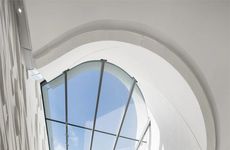
This Museum Was Designed to Look Like the Interior of a Cave
Mishal Omar — May 15, 2016 — Art & Design
References: furuichiarch.sakura.ne.jp & dezeen
Designed by Architecture studio Furuichi and Associates in Japan, this museum roof was created to represent Japan's Jomon period.
The most riveting aspect of this museum is its multifaceted ceiling, which is made up of wooden structures that come out of the roof in a jagged, multi-dimensional fashion. The historical relevance of this building and location is also interesting since it was built on top of the ruins of a structure from the Jomon period -- which was between 12,000 and 3,000 BC. The cave-like appearance of this structure invokes the feeling of the "hunter-gatherer lifestyle" in which the people of this time lived. They went on to create their own structures that had a cave-like appearance and this museum aims to replicate that.
The museum has a large open space and also offers a view of the ruins from the Jomon period.
The most riveting aspect of this museum is its multifaceted ceiling, which is made up of wooden structures that come out of the roof in a jagged, multi-dimensional fashion. The historical relevance of this building and location is also interesting since it was built on top of the ruins of a structure from the Jomon period -- which was between 12,000 and 3,000 BC. The cave-like appearance of this structure invokes the feeling of the "hunter-gatherer lifestyle" in which the people of this time lived. They went on to create their own structures that had a cave-like appearance and this museum aims to replicate that.
The museum has a large open space and also offers a view of the ruins from the Jomon period.
Trend Themes
1. Multifaceted Museum Roofs - Designing museum roofs with a unique multifaceted structure presents opportunities for creating visually captivating and immersive cultural experiences.
2. Replicating Hunter-gatherer Structures - Replicating the cave-like appearance of hunter-gatherer structures in contemporary architecture opens up possibilities for exploring historical periods and creating unique museum experiences.
3. Historical Relevance in Architecture - Incorporating historical ruins into modern architectural designs allows for the preservation and celebration of cultural heritage while providing educational experiences for visitors.
Industry Implications
1. Museum Architecture - The field of museum architecture can benefit from innovative designs that incorporate multifaceted roofs and aim to replicate ancient structures, creating awe-inspiring spaces for cultural preservation and education.
2. Cultural Tourism - The cultural tourism industry can leverage the trend of designing museums with historical relevance and replicating cave-like structures to attract tourists seeking immersive and educational experiences.
3. Cultural Heritage Preservation - The field of cultural heritage preservation can explore collaborations with architects to incorporate historical ruins into contemporary structures, promoting the conservation and appreciation of ancient civilizations.
1.6
Score
Popularity
Activity
Freshness























